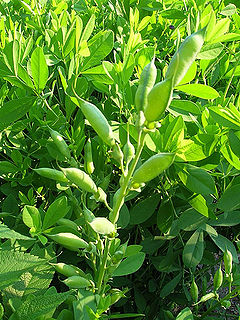Difference between revisions of "Peas"
(Created page with "{{Infobox_Vegetables | image = peas.jpg | carrying temperature = 0°C to 1°C | highest freezing point = -0,6°C | accep...") |
|||
| Line 18: | Line 18: | ||
There are three types of edible peas. The most common is the garden or green pea. This pea has a tough pod, which is discarded prior to eating. Most often these peas are frozen or processed. | There are three types of edible peas. The most common is the garden or green pea. This pea has a tough pod, which is discarded prior to eating. Most often these peas are frozen or processed. | ||
| − | The other two types of peas have soft, edible pods. The snow or sugar pea has a flat pod with minimal development of the seeds, whilst the sugar snap pea or snap pea has developed seeds and is fully rounded. The sugar snap pea is the result of a cross between the snow pea and an unusual tightly podded pea with thick walls. | + | The other two types of peas have soft, edible pods. The snow or [[sugar]] pea has a flat pod with minimal development of the [[seeds]], whilst the sugar snap pea or snap pea has developed seeds and is fully rounded. The sugar snap pea is the result of a cross between the snow pea and an unusual tightly podded pea with thick walls. |
Good quality peas should be uniformly bright green, fully turgid and free from defects and mechanical damage. Stems and calyxes should be green. Green peas lose sugars and flavour rapidly after harvest unless they are promptly cooled to 0°C. | Good quality peas should be uniformly bright green, fully turgid and free from defects and mechanical damage. Stems and calyxes should be green. Green peas lose sugars and flavour rapidly after harvest unless they are promptly cooled to 0°C. | ||
| Line 43: | Line 43: | ||
| − | + | ||
[[Category:Perishables]] | [[Category:Perishables]] | ||
[[Category:Products]] | [[Category:Products]] | ||
Revision as of 17:27, 14 March 2012
| Infobox on Peas | |
|---|---|
| Example of Peas |  |
| Freshness facts | |
| Optimum carrying temperature | 0°C to 1°C |
| Highest freezing point | -0,6°C |
| Acceptable product temp. at loading into containers | Max. 2°C above carrying temperature |
| Optimum humidity | 95% to 100% |
| Ventilation setting for containers | 25 m³/hr |
| Storage life | 1-2 weeks |
| Climacteric / non-climacteric | Non-climacteric |
| Ethylene production | Very low |
| Ethylene sensitivity | Medium |
| Modified / controlled atmosphere | 2%-3% O2; 2%-3% CO2 |
| Potential benefits | Slight advantage |
| Availability | |
| On demand | |
Peas
Contents
Harvesting and Handling
There are three types of edible peas. The most common is the garden or green pea. This pea has a tough pod, which is discarded prior to eating. Most often these peas are frozen or processed.
The other two types of peas have soft, edible pods. The snow or sugar pea has a flat pod with minimal development of the seeds, whilst the sugar snap pea or snap pea has developed seeds and is fully rounded. The sugar snap pea is the result of a cross between the snow pea and an unusual tightly podded pea with thick walls.
Good quality peas should be uniformly bright green, fully turgid and free from defects and mechanical damage. Stems and calyxes should be green. Green peas lose sugars and flavour rapidly after harvest unless they are promptly cooled to 0°C.
Film-packaging serves to minimise moisture loss, but the film must be sufficiently permeable to preclude the possibility of anaerobic respiration and resultant off-odours.
Cooling and Storage
All three types of peas can be stored for 1 to 2 weeks at 0°C with 95% to 98% RH. Garden peas store better unshelled than shelled, possibly because shelling damages the peas. If there is surface moisture on peas, it is essential that they be stored below 2°C.
Edible-pod peas are highly perishable and will not maintain good quality for more than 2 weeks. Wilting, yellowing of pods, loss of tenderness, development of starchiness and decay are likely to increase following storage beyond 14 days; defects occur faster at common distribution conditions of 5 to10°C.
Peas are not sensitive to low temperature and should be stored as close to 0°C as possible without freezing.
Controlled atmosphere considerations
Reports vary widely in the benefit of CA for sugar and snap peas. Atmospheres of 2% to 3% O2 and 2% to 3% CO2 are considered to offer the best, but moderate, benefit to peas beyond that of rapid cooling and proper storage. Low O2 may promote off-flavours and off-odours.
Peas are moderately sensitive to exogenous ethylene. Accelerated yellowing and decay will result from extended exposure to low levels of ethylene during distribution and short-term storage. The calyx is more sensitive to ethylene than the pod.
Storage disorders
Anthracnose, Asochyta pod spot, Bacterial soft rot, Blight, Powdery mildew, Watery soft rot, Wilting.











